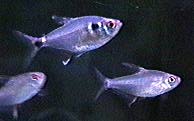Individual Fish Description Page


This page will give a completely detailed profile of the
selected fish, from A to Z. The profiled fish will be
chosen randomly by Badman, and will come from the complete
genre of tropical fish. I will try to up-date the profile
on a monthly basis. If you have a specific fish you want
profiled please
E-MAIL
ME
and I will try to fill your request.


Hyphessobrycon Pulchripinnis
Classification
- Order: Crpriniformes
- Sub-order: Characoidei
- Family: Characidae
- Genera: Hyphessorbrycon
Common name
Lemon Tetra
Distribution
Widespread throughout South America, But not found in great numbers.
General Body Form
Typical for the Genus. Medium tall and very compressed. Grows tu about two inches.
Coloration
The top of the eye is very Red. The end and edge of the Dorsal fin is Black. The back rays on the Anal fin are Black. the front ones are bright Yellow. The body is transparent with a slight Yellowish tinge. A Iridescent stripe extends laterally from the gill cover to the start of the Caudal fin.
Maintenance
An Easily kept fish, the Lemon Tetra can be housed in almost any community aquarium. For best show the tank should be small to medium in size and contain from ten to fifty-five gallons of water. The water should be clear, soft to medium in hardness and with a pH on the acidic side. The temperature should be maintained between 72oand 79o. As with all fish a portion of the water should be changed monthly. Feeding is no problem as they will accept all flake food as well as any live food you can provide. The tank should have open areas for swimming as well as areas with dense vegetation for hiding. The Lemon tetras subtle colors can be enhanced through the use of a dark substrate
Breeding
The lemon Tetra is not one of the easiest Tetras to spawn. It seems that the females have trouble expelling the eggs and so several females should be combinned with one male to increase the chance of success. Eggs are laid in fine leaved plants in the scattering method. The eggs hatch in about twenty-four hours and the mortality rate is fairly high. Once the young survive the first couple of days they prove to be very hardy. The parents give no care and will eat the eggs and young and so should be removed as quickly as possible after spawning.


to profile page.

Email:
badman2nd@hotmail.com



